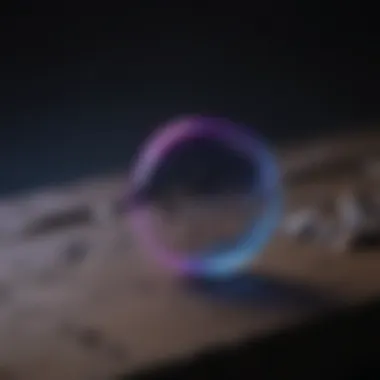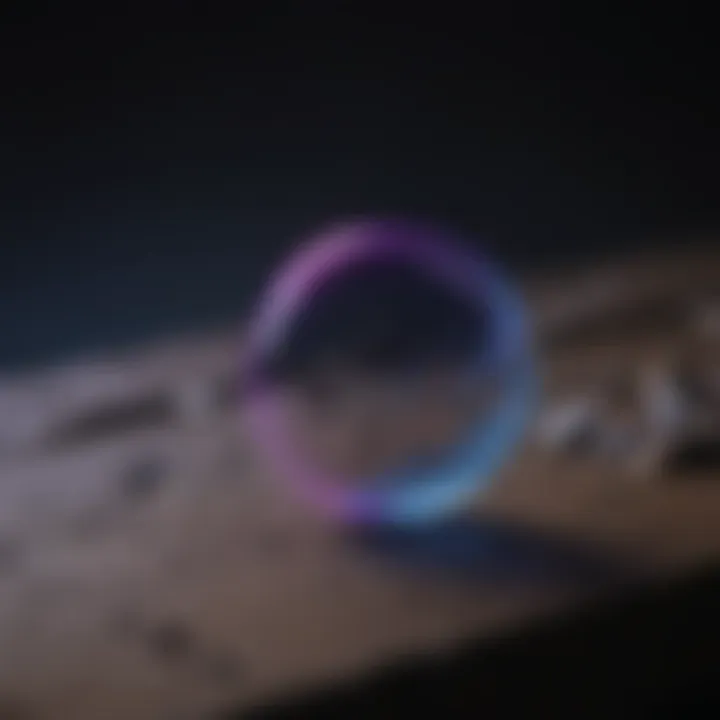Understanding Ultraviolet Wavelength: Implications and Applications


Intro
Ultraviolet (UV) wavelengths are a crucial part of the electromagnetic spectrum, positioned between visible light and X-rays. This section explores the importance of understanding these wavelengths, which can have enticing implications across various fields, from health to technology. The nature of UV radiation is often misunderstood, yet its influence is significant. It plays a vital role in numerous processes, both beneficial and harmful. This article intends to unpack the foundational aspects of ultraviolet wavelengths, offering insights that are relevant to students, researchers, educators, and professionals.
Research Overview
Understanding UV wavelengths requires careful examination of both their properties and their interactions with various materials. Researchers engage in different methodological approaches to capture the complexities involved.
Methodological Approaches
The study of UV wavelengths frequently employs experimental and theoretical methods. Here are few approaches:
- Spectrophotometry: This technique analyzes the absorption of UV light by substances, revealing information about their chemical structures.
- Modeling and Simulation: Scientists use computer models to simulate the effects of UV radiation, aiding in understanding its behavior and impact.
- Field Studies: Research in natural environments assesses the effects of UV on ecosystems, from plant growth to animal behavior.
Significance and Implications
The importance of UV wavelengths extends to many sectors. Here are significant implications of UV research:
- Health: UV radiation is crucial in vitamin D synthesis but can also lead to health issues, such as skin cancer.
- Technology: Innovations, such as UV sterilization systems, showcase practical applications in public health and safety.
- Environmental Science: Monitoring UV levels helps scientists understand climate change's effects on ecosystems.
"The study of ultraviolet wavelengths not only broadens scientific knowledge but also holds the key to addressing pressing global challenges."
Current Trends in Science
In recent years, research around ultraviolet wavelengths has experienced a resurgence. This section reviews contemporary trends that are shaping the field.
Innovative Techniques and Tools
Advancements in technology offer new avenues for studying UV wavelengths. Key developments include:
- High-Resolution Spectroscopy: This allows scientists to dissect the properties of UV light in intricate detail, revealing new insights.
- Portable UV Sensors: These devices enable real-time monitoring of UV radiation, crucial for public health initiatives.
Interdisciplinary Connections
Research on UV wavelengths often intersects with various fields such as:
- Biology: The impact of UV on living organisms cannot be overlooked, influencing areas like evolution and adaptation.
- Chemistry: Understanding chemical reactions prompted by UV light leads to advancements in materials science.
- Environmental Studies: UV radiation's role in ozone depletion emphasizes interdisciplinary approaches in addressing environmental concerns.
Prolusion to Ultraviolet Wavelength
The topic of ultraviolet wavelengths carries significant importance in both theoretical and practical domains. In the scientific community, understanding ultraviolet radiation is crucial. It enhances our knowledge of electromagnetic spectrum, which includes various forms of light. These wavelengths, typically ranging from about 10 nanometers to 400 nanometers, sit between visible light and X-rays. This position makes them uniquely influential in many fields.
UV radiation plays diverse roles, from driving photosynthesis in plants to influencing the synthesis of vitamin D in humans. However, it is also associated with health risks, such as skin cancer. Thus, a comprehensive understanding of UV wavelengths is essential not only for scientific inquiry but also for public health and safety.
Moreover, developments in technology harness these wavelengths for various applications. Medical treatments utilizing UV light are becoming more common. In industries, UV radiation is essential for processes like sterilization and curing. Therefore, examining ultraviolet wavelengths allows for a better understanding of their impacts and benefits across multiple sectors.
Definition of Ultraviolet Wavelength
Ultraviolet (UV) wavelengths are part of the electromagnetic spectrum, classified by shorter wavelengths than visible light. The term 'ultraviolet' translates to 'beyond violet,' a nod to its position above the visible spectrum. As stated before, UV radiation encompasses wavelengths ranging from approximately 10 to 400 nanometers. These wavelengths are subdivided into three main categories: UVA, UVB, and UVC.
- UVA (320-400 nm): This type penetrates the Earth’s atmosphere most effectively and can reach the skin. It contributes to skin aging and long-term skin damage.
- UVB (280-320 nm): UVB wavelengths are partially absorbed by the ozone layer. They are primarily responsible for sunburn and have a key role in the formation of vitamin D in the skin.
- UVC (100-280 nm): This type is highly energetic but is almost entirely absorbed by the atmosphere. Despite its low presence on Earth, UVC has significant applications in disinfection processes.
In summary, understanding the definition and classification of ultraviolet wavelengths allows us to appreciate their unique interactions with biological systems and ecosystems.
Historical Context of UV Research
The history of ultraviolet research dates back to the early 19th century. In 1801, German physicist Johann Wilhelm Ritter conducted experiments with sunlight and discovered UV light. He observed that silver chloride darkened faster under UV light compared to visible light. This pivotal moment marked the beginning of a deeper investigation into the properties and effects of UV radiation.
As research progressed, the effects of UV radiation on living organisms became a focal point. In the 20th century, the links between UV exposure and skin conditions gained attention. Studies revealed that overexposure could lead to adverse effects like skin aging and cancer.
Today, the research has evolved to encompass various applications, from medicine to environmental science. With the ongoing advances in technology, the influence of UV radiation continues to expand. Understanding its historical context provides valuable insights into its current applications and future potential.
"Understanding the historical context of UV research highlights the importance of continuing investigation into its implications for health and environment."


Fundamental Properties of Ultraviolet Radiation
The study of ultraviolet radiation plays a pivotal role in comprehending its diverse impacts across various fields. Understanding the fundamental properties of UV light allows researchers and professionals to harness its benefits while mitigating potential risks. This section explores key aspects such as wavelength range and categories, the nature of UV light, and measurement techniques, providing a comprehensive overview of these elements.
Wavelength Range and Categories
Ultraviolet radiation is classified into several categories based on its wavelength, which spans from approximately 10 nanometers to 400 nanometers. This range can be divided into four main regions:
- UVA (320-400 nm): Known as the longest wavelength UV, it penetrates deep into the skin and is primarily responsible for premature skin aging.
- UVB (280-320 nm): Associated with sunburn and skin cancer, UVB radiates at moderate wavelengths and is crucial for vitamin D synthesis.
- UVC (100-280 nm): Largely absorbed by the Earth's atmosphere, UVC has germicidal properties and is commonly used in sterilization processes.
- Extreme UV (10-100 nm): This range finds application in advanced technologies, including photolithography used in semiconductor manufacturing.
Understanding the specific properties of each category is essential for determining their applications and safety measures in fields such as medicine and environmental science.
Nature of Ultraviolet Light
Ultraviolet light possesses unique characteristics that differentiate it from other forms of electromagnetic radiation. Notably, its energy level is significantly higher than visible light, which enables it to induce various chemical and biological reactions. The consequences of these reactions are pertinent in countless applications:
- Photochemical Reactions: UV light can initiate chemical changes, leading to processes such as polymerization and photo-oxidation.
- Biological Effects: It can impact living organisms, influencing processes like photosynthesis and skin responses in humans due to DNA damage.
These characteristics underscore the dual nature of ultraviolet radiation: as a tool for scientific advancement and as a factor to be managed carefully due to its potential harmful effects.
Measurement Techniques
Accurate measurement of ultraviolet radiation is crucial for research, safety, and application purposes. Various techniques are employed, each with its own advantages and limitations:
- Spectrophotometry: Involves measuring the intensity of UV light across different wavelengths, which is essential in analyzing substances' UV absorptive properties.
- Radiometry: This technique measures the power of UV radiation emitted from various sources, providing valuable data for environmental and health assessments.
- Fluorometry: Used for detecting and analyzing fluorescent compounds, this method is important in biological and chemical research.
These measurement techniques are essential for scientists and professionals in ensuring accurate assessments of UV exposure and its ramifications on health, technology, and the environment.
Interaction of UV Light with Matter
Ultraviolet light's interaction with matter is a critical aspect of its study. Understanding how UV light behaves when it encounters different substances helps elucidate its applications and implications. This section dissects various elements pertinent to this interaction, including absorption and transmission characteristics, the chemical reactions it induces, and notable phenomena like fluorescence and phosphorescence.
Absorption and Transmission
Absorption of UV light occurs when photons possess sufficient energy to elevate electrons in a material to higher energy levels. This is significant in various fields, such as photochemistry and materials science. Some materials absorb UV radiation effectively while others transmit it.
The difference in these properties is crucial for applications in UV sterilization, where specific wavelengths target and deactivate microorganisms. Borosilicate glass, for instance, transmits UV light in the UV-C range, making it suitable for laboratory equipment
Considerations for absorption and transmission include:
- Wavelength Dependency: The amount of UV light absorbed or transmitted is heavily dependent on the specific wavelength involved. Different materials respond uniquely to these wavelengths.
- Material Composition: The chemical structure of a substance determines its ability to absorb UV radiation. For example, proteins and nucleic acids exhibit distinct absorption spectra in the UV range, influencing biological responses.
- Environmental Factors: Temperature and humidity may affect how materials absorb or transmit UV light, thereby impacting the efficiency of certain UV applications.
Chemical Reactions Induced by UV Light
UV light can drive chemical reactions that do not occur under visible light. This is particularly relevant in polymer science and organic synthesis. The energy from UV photons can break bonds in molecules, leading to various interactions. For example, UV irradiation may lead to photopolymerization, where monomers combine under UV light to form polymers.
Important aspects include:
- Photodegradation: Exposure to UV radiation can degrade materials. Plastics, for instance, may become brittle when exposed over time, which is a crucial consideration in product design and longevity.
- Photosensitization: Certain substances absorb UV light and subsequently trigger chemical reactions in nearby molecules. This is often observed in biological systems, where UV light influences processes such as DNA repair or mutation.
- Environmental Impact: Understanding these reactions helps evaluate the implications of UV light in environmental contexts, such as its role in atmospheric chemistry and ecological systems.
Fluorescence and Phosphorescence Phenomena
Fluorescence and phosphorescence are two phenomena that arise from the interaction of UV light with matter, where absorbed energy is re-emitted as light.
- Fluorescence occurs almost immediately after absorption, with materials emitting light quickly as they return to their ground state. It is commonly used in biological staining and various lighting applications.
- Phosphorescence, on the other hand, involves a delayed emission of light, lasting from milliseconds to hours after the excitation source has been removed. This has applications in safety signage and glow-in-the-dark materials.
Both phenomena are used extensively in scientific research and industrial applications, enhancing visibility and the detection of specific materials or conditions. Understanding these interactions provides a deeper insight into how materials can be utilized in various sectors, including healthcare and environmental monitoring.
By understanding these principles, researchers and professionals can devise methods that leverage UV light effectively while being mindful of its implications.
Biological Implications of Ultraviolet Radiation
The biological implications of ultraviolet (UV) radiation are extensive and multifaceted. This section explores how UV wavelengths affect living organisms, specifically focusing on humans and the wider ecological system. Understanding these impacts is crucial for several reasons. First, it helps in assessing risks to human health and the environment. Second, it provides insight into how UV radiation can be harnessed for beneficial purposes in medical and industrial applications. Finally, awareness of these implications allows for informed decisions regarding safety and regulation.


Effects on Human Health
Ultraviolet radiation has both positive and negative consequences for human health. On one hand, UV radiation plays a critical role in the synthesis of Vitamin D in the skin, which is essential for bone health and immune function. Moderate exposure provides significant benefits, particularly in areas where sunlight is limited.
However, excessive UV exposure poses serious health risks. The most well-documented effect is skin cancer, particularly melanoma, which can be fatal if not detected early. Additionally, UV radiation can lead to premature aging of the skin, exacerbating conditions such as sunburn and skin damage. Other health issues include cataracts and weakened immune response, which increase susceptibility to infections.
- Significant health concerns include:
- Skin cancer risk.
- Eye damage, including cataracts.
- Immune system suppression.
Preventive measures, such as the use of sunscreen, protective clothing, and limiting exposure during peak sun hours, are vital in mitigating these negative impacts.
Ecological Impact on Flora and Fauna
The ecological implications of UV radiation extend well beyond human health. Plants, animals, and entire ecosystems react in various ways to UV exposure. For instance, certain plant species have developed protective adaptations, such as thicker leaves or increased production of UV-absorbing compounds. These adaptations enhance their survival in environments with higher UV levels.
Animals are not immune to these effects either. Increased UV radiation can disrupt the developmental stages of amphibians and compromise reproductive success in various species. Moreover, ultraviolet radiation affects phytoplankton, a foundational element of aquatic food webs. Reductions in phytoplankton populations can have cascading effects throughout marine ecosystems.
The ecological impacts are making it clear that understanding UV radiation effects is critical:
- Key impacts on ecosystems include:
- Altered plant growth patterns.
- Disruption in food chains.
- Effects on biodiversity and species survival.
"Awareness of the ecological implications of UV radiation is essential for conservation efforts and sustaining biodiversity."
Research on these effects on biological systems leads to a profound appreciation for UV radiation's role in life processes. Expanding this knowledge can aid in efforts to mitigate adverse outcomes in both human health and ecological balance.
Applications of Ultraviolet Wavelength
Understanding the applications of ultraviolet (UV) wavelengths is essential. It allows us to appreciate both their scientific significance and real-world implications. The role of UV light cuts across various disciplines including medicine, industry, and environmental science. Here, we will elaborate on key applications of UV radiation, highlighting its benefits and relevant considerations.
UV Light in Medical Treatments
UV light has a long history in medical applications. One major area is its use in phototherapy for skin conditions like psoriasis and eczema. Doctors expose affected skin to UV light under controlled conditions. This treatment can reduce symptoms significantly.
Moreover, UV radiation plays a crucial role in sterilization. Hospitals utilize UV lamps to disinfect surgical tools, reducing the risk of infections. The combat against airborne pathogens also benefits from UV disinfection systems. These systems help in cleaning air and surfaces in medical facilities, enhancing patient safety.
However, it is important to approach UV medical treatments with caution. Overexposure can lead to skin damage or increase the risk of skin cancer. Therefore, guidelines and strict protocols must govern its use in healthcare settings.
Industrial Uses of UV Radiation
In the industrial sphere, UV radiation finds multifaceted applications. One notable use is in the curing of inks and coatings. Manufacturers employ UV light to quickly dry and harden these materials, which boosts production efficiency. Companies like UV Technologies specialize in these processes, aiding significant time savings in various manufacturing workflows.
UV radiation is also common in quality control. Industries use it to detect surface defects in products. By illuminating materials with UV light, flaws become more visible due to fluorescence. This method increases production quality and consumer safety.
Additionally, UV lamps are integral to water purification systems. These systems kill harmful microorganisms without the introduction of chemicals. This technology is widely adopted in municipal water treatment facilities and offers a sustainable solution to clean drinking water.
Environmental Monitoring and Cleanup
The application of UV wavelengths extends into environmental science. Scientists utilize UV radiation for monitoring pollutants. Certain materials fluoresce under UV light, enabling precise detection of harmful substances in water and soil. This ability enhances the efficiency of environmental assessments.
In terms of cleanup, UV radiation is gaining traction. It is used in advanced oxidation processes to degrade contaminants in wastewater. This method transforms harmful chemicals into less toxic substances, ultimately improving environmental health.
Furthermore, UV light supports ecological research. It plays a role in assessing the health of ecosystems by examining the effects of UV exposure on various organisms. This research aids in understanding and mitigating the impact of environmental changes.
"The future of UV applications appears promising, with ongoing research and innovations providing novel solutions to both medical and environmental challenges."
In summary, the applications of ultraviolet wavelengths are diverse and impactful. From medical treatments to industrial processes and environmental efforts, the benefits of UV light are substantial, though they are not without considerations. Its continued exploration and integration into various fields hold potential for significant advancements.
Technological Advances in UV Research
The domain of ultraviolet (UV) research has witnessed significant advancements over recent years. These developments not only enhance our understanding of UV radiation but also expand its applications across various fields. Innovations in technology have made it possible to utilize UV light in ways that were previously unimaginable, offering benefits in medical, industrial, and environmental contexts.


Innovations in UV Light Sources
The evolution of UV light sources plays a crucial role in UV research. Traditional methods often relied on high-pressure mercury lamps. However, recent innovations have led to the development of low-pressure UV lamps, LEDs, and excimer lasers that operate at specific wavelengths. These advancements enable more precise applications of UV light, reducing energy consumption and minimizing harmful effects on the environment.
These modern UV sources provide several advantages:
- Enhanced Efficiency: New light sources, such as UV LEDs, are more energy-efficient compared to older technologies. They consume less power and have a longer operational lifetime.
- Specific Wavelength Emission: With the ability to emit specific wavelengths, scientists can control the interaction of UV light with matter more effectively, improving outcomes in various applications.
- Compact Size: Smaller UV sources facilitate easier integration into existing systems and devices, allowing businesses and laboratories to implement UV technology without extensive modifications.
The result is a significant improvement in how UV technology is utilized, which translates into better performance in applications ranging from medical sterilization to curing of materials in various industries.
Advanced Detection Techniques
As UV research continues to advance, so does the need for robust detection techniques. Analyzing UV radiation's effects on matter requires precision and accuracy. New detection technologies have emerged to meet these demands, which are essential for both laboratory and fieldwork applications.
Some notable techniques include:
- Spectroscopy: This involves the study of the interaction between UV light and substances. Instruments like UV-Vis spectrophotometers allow scientists to analyze the properties of materials based on how they absorb or transmit UV radiation.
- Photodetectors: These devices convert UV light into an electric signal, enabling the measurement of UV radiation levels with high sensitivity. This is particularly valuable in environmental monitoring, where detecting low levels of UV radiation can be critical.
- Imaging Techniques: Advanced imaging systems are capable of visualizing UV light patterns and interactions, thereby providing insights into processes that were previously difficult to observe.
"The advancements in detection techniques not only support fundamental research but also enhance practical applications such as monitoring UV exposure in occupational health settings."
As a result of these advances, scientists can more effectively utilize UV light in their research, leading to breakthroughs across multiple scientific disciplines.
In summary, technological advances in UV research represent a transformative period for the field. The innovations in UV light sources and detection techniques provide enhanced capabilities that foster fundamental understanding and practical applications of ultraviolet radiation. As this field evolves, we can anticipate more developments that will continue to push the boundaries of what is possible in UV research and its applications.
Regulatory and Safety Considerations
The regulation and safety considerations of ultraviolet (UV) light are crucial in the context of its widespread applications across various fields, including medical, industrial, and environmental sectors. Proper understanding and implementation of these guidelines not only ensure the well-being of users but also enhance the efficacy of UV applications. As research into UV technology continues to evolve, these regulatory frameworks must adapt to address new challenges and emerging technologies. Furthermore, awareness and compliance with safety measures are pivotal in mitigating risks associated with UV exposure, ensuring a responsible approach to its utilization.
Guidelines for UV Exposure
Guidelines surrounding UV exposure provide structured information aimed at minimizing risks involved. These guidelines are often established by health and safety organizations and regulatory bodies. The main focus is on defining safe exposure limits, considering both intensity and duration.
Key aspects of these guidelines include:
- Measurement of UV Levels: Regular monitoring of UV radiation levels is important to ensure they are within safe limits. Devices such as UV meters should be used for accurate assessment.
- Peak Wavelength Concerns: Different UV wavelengths have varying effects. For instance, UV-C (100–280 nm) can be harmful, while UV-A (320–400 nm) can lead to skin aging over time. Regulations should specify limits based on specific wavelengths.
- Occupational Health Standards: Workers in industries that use UV light must be adequately trained about the risks and precautions. Standards like those established by the Occupational Safety and Health Administration (OSHA) provide frameworks for ensuring safe work environments.
- Policy Updates: As new research emerges, guidelines need continual revision. It’s essential for organizations to stay updated on the latest recommendations from authorities.
The emphasis on precise standards helps in protecting individuals while leveraging the benefits of UV technologies effectively.
Protective Measures in UV Applications
Protective measures in UV applications are essential for safeguarding workers and the environment from potential harm. These measures involve both physical and procedural strategies to minimize UV exposure risks.
The protective strategies often include:
- Personal Protective Equipment (PPE): The use of specific PPE such as UV-blocking goggles, gloves, and skin covers is vital in workplaces with high UV exposure levels. The correct equipment reduces the risks significantly.
- Shielding and Barriers: Installing UV shielding in places where UV light is utilized helps prevent unintended exposure for both workers and the public. This includes glass filters and protective barriers, which can effectively block harmful UV wavelengths.
- Training and Education: Comprehensive training programs for personnel using UV radiation are crucial. These should cover the risks associated with UV exposure and proper usage protocols.
- Emergency Procedures: Establishing clear procedures for incidents related to UV exposure ensures timely responses to accidents. This can include immediate first-aid measures and protocols for reporting incidents.
Future Directions in Ultraviolet Research
The future of ultraviolet research is an area of immense promise and intrigue. As science progresses, understanding the subtleties of ultraviolet wavelengths might unlock new applications and enhance existing technologies. Innovations in UV research can contribute to various fields including medicine, environmental science, and materials science.
Advancements in understanding the interactions of ultraviolet radiation with different materials may lead to significant breakthroughs. For instance, studying how UV light can be harnessed or moderated could improve safety standards and efficiency in its diverse applications. The research also offers critical insights into environmental effects, particularly in how UV light impacts ecosystems and climate change.
Emerging Trends and Innovations
Emerging trends in UV research are rapidly evolving, shaped by technological advancements and shifting societal needs. One prominent trend is the development of more efficient UV light sources, including newer generation LEDs. These devices can emit targeted wavelengths that are less harmful, yet effective for applications in sterilization, disinfection, and medical treatments.
Additionally, innovations in photonic sensing technologies allow researchers to detect UV radiation more accurately. This helps in monitoring UV levels in various environments. Improved sensor accuracy is vital in both ecological studies and health applications, ensuring better understanding and mitigation of UV radiation effects.
Moreover, novel materials such as photonic crystals and quantum dots are being explored for their unique properties related to UV light manipulation. These materials offer extraordinary potential for enhancing UV applications in data transmission and advanced imaging technologies.
Potential Areas for Further Study
An array of potential areas for further study is apparent in ultraviolet research. One crucial aspect is the exploration of UV’s effects on different biological systems. As we delve deeper into genomics and molecular biology, understanding how UV radiation induces mutations can play a key role in cancer research and prevention strategies. Further studies may focus on the long-term implications of UV exposure on human health and the potential to develop effective protective measures.
Research into the ecological impacts of UV radiation also warrants further examination. Questions remain about how shifts in UV exposure due to ozone depletion or climate change affect various species’ behavior, reproduction, and survival. Moniotoring these changes can be critical in developing conservation strategies.
Furthermore, interdisciplinary research that combines UV science with fields like nanotechnology and fluid dynamics may reveal innovative applications. For instance, employing UV light in the development of advanced materials, water purification systems, and energy production systems could pave the way for sustainable technologies in the future.
"The exploration of ultraviolet wavelengths not only advances scientific knowledge but also holds significant potential for societal benefits."
By focusing on emerging trends and potential areas for further study, researchers can better position themselves to make impactful strides in the fields influenced by ultraviolet wavelengths.



